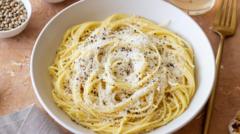The UK's Good Food website faced backlash from Italians after publishing a recipe for the classic dish cacio e pepe, which many claimed distorted its traditional ingredients and preparation.
Italians Outraged by Good Food's Recipe for Cacio e Pepe

Italians Outraged by Good Food's Recipe for Cacio e Pepe
A recipe for the traditional Roman dish cacio e pepe on a UK website has ignited a firestorm of criticism in Italy.
Italians have expressed strong indignation following the publication of a recipe for the traditional Roman dish cacio e pepe by the UK-based Good Food website, which has been accused of undermining the authenticity of this cherished cuisine. Public reaction surged as the site described cacio e pepe as a quick meal option and included non-traditional ingredients, specifically listing spaghetti, black pepper, parmesan, and butter—sigificantly straying from the original recipe, which traditionally calls for only three: spaghetti, black pepper, and solely pecorino cheese.
The controversy escalated to the point where an association representing restaurants in Italy took the issue up with the British embassy in Rome. Claudio Pica, president of Italy's food association, expressed astonishment at the misrepresentation on such a prominent UK platform, formerly associated with the BBC. He emphasized that the loved dish has been a part of culinary heritage in the Lazio region for generations and that mislabeling a recipe with incorrect ingredients as "traditional" was misleading to readers, especially international ones.
The outrage was echoed across various Italian media outlets, with comments highlighting the insensitivity of such a faux pas, particularly in light of historical British perspectives on Italian cuisine. A journalist from RAI remarked on the unfairness of constantly being compared to the BBC only to have such a grievous error occur. Other restaurant owners echoed similar sentiments, categorically stating that the version presented was akin to "pasta Alfredo" rather than cacio e pepe.
While culinary adaptations are common, traditionalists underlined the importance of preserving authentic recipes. Restaurant owner Giorgio Eramo argued that meaningful alterations could be made, but not when they distort the essence of recognized dishes. "You cannot call it cacio e pepe if you add butter or cream; that is not the original," he asserted.
Locals have long held a pride in their culinary traditions, often taking offense when foreigners experiment with their recipes. As a result, the debate stirred up feelings of territoriality over Italy's gastronomic identity. Some have suggested that while the outrage may seem excessive to outsiders, it stems from a deeper connection to food as an integral aspect of Italian culture.
Immediate Media, the owner of Good Food, has been contacted for a response regarding the escalating backlash.




















